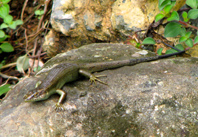Abstract
Menezes et al. (2010) show that Mugil cephalus Linnaeus, 1758 is different from Mugil liza Valenciennes 1836, the latter being the mullet found along the Atlantic coast of South America. They also suggest that individuals identified as M. cephalus from the northwest Atlantic could represent a population of M. liza in this region, since they doubt the presence of M. cephalus in waters colder than the ones of the West Indies. In order to clarify the presence of M. cephalus in the northwest Atlantic, this study compares meristic and morphometric measurements of M. cephalus and M. liza from the Gulf of Mexico with those obtained by Menezes et al. (2010) for M. liza from South America and for M. cephalus in the Mediterranean Sea. Results show that there are differences in both morphometric and meristic data between the two species. The morphometric measure that differentiates these species is the distance from the snout to the dorsal fin, which is positioned backwards in M. liza compared with M. cephalus. The body width is consistently greater in M. cephalus than M. liza. The meristic character that discriminates between both species is the number of scales in the longitudinal series that, in M. cephalus, ranges from 38 to 43 while in M. liza between 32 to 39. The information presented in this work confirms the presence of M. cephalus in the Gulf of Mexico and the sympatric presence of M. liza is established, even if its abundance is quite low.
References
Alvarez-Lajonchere, L.S. (1978a) Alimentación natural de Mugil liza, Mugil curema, Mugil trichodon y Mugil hospes (Pisces: Mugilidae) en las lagunas costeras de Tunas de Zaza, Cuba. Ciencias Ser. 8. Revista de Investigaciones Marinas, 41, 3–37.
Alvarez-Lajonchere, L.S. (1978b) Algunos aspectos sobre la reproducción de Mugil liza (Pisces: Mugilidae) en Tunas de Zaza, Cuba. Primer Forum Científico. Centro de Investigaciones Pesqueras. Abril 1978. CIP 78. IV/I: 17 p.
Anderson, W.W. (1958) Larval development, growth and spawning of striped mullet (Mugil cephalus) along the South Atlantic coast of the United States. Fishery Bulletin of the Fish and Wildlife Service (US) Res Rep, 58, 501–519.
Arnold, E.L. & Thompson, J.R. (1958) Offshore spawning of the striped mullet, Mugil cephalus, in the Gulf of Mexico. Copeia, 2, 130–132.
http://dx.doi.org/10.2307/1440554Briggs, J.C. (1960) Fishes of worldwide (circumtropical) distribution. Copeia, 1960, 171–180.
http://dx.doi.org/10.2307/1439652Castro-Aguirre, J.L., Espinosa, H. & Schmitter-Soto, Y.J.J. (1999) Ictiofauna estuarina, lagunar y vicaria de México. Limusa, México, D. F., 704 pp.
Chang, C.W., Iizuka, Y. & Tzeng, W.N. (2004) Migratory environmental history of the grey mullet Mugil cephalus as revealed by otolith Sr:Ca ratios. Marine Ecology Progress Series, 269, 277–288.
http://dx.doi.org/10.3354/meps269277Colín, A. (2014) Variabilidad y estructura genética de la lisa Mugil cephalus L. en Golfo de México y el Pacífico Mexicano. Master Degree Thesis. Universidad Autónoma Metropolitana, 71 pp.
Durand, J.D., Shen, K.N., Chen, W.J., Jamandre, B.W., Blel, H., Diop, K., Nirchio, M., García, de León F.J., Whitfield, A.K., Chang, C.W. & Borsa, P. (2012) Systematics of the grey mullet (Teleostei: Mugiliformes: Mugilidae): Molecular phylogenetic evidence challenges two centuries of morphology-based taxonomic studies. Molecular Phylogenetics and Evolution, 64, 73–92.
http://dx.doi.org/10.1016/j.ympev.2012.03.006Eschmeyer, W.N. & Fricke, R. (Eds.) (2009) Catalog of Fishes electronic version (9 September 2009) Available from: http://research.calacademy.org/ichthyology/catalog/fishcatmain.asp
Fraga, E., Schneider, H., Nirchio, M., Santa-Brigida, E., Rodrigues- Filho, L.F. & Sampaio, I. (2007) Molecular phylogenetic analyses of mullets (Mugilidae, Mugiliformes) based on two mitochondrial genes. Journal of Applied Ichthyology, 23, 598–604.
http://dx.doi.org/10.1111/j.1439-0426.2007.00911.xGonzález-Castro, M., Heras, S., Cousseau, M.B. & Roldán, M.I. (2008) Assessing species validity of Mugil platanus Günther, 1880 in relation to Mugil cephalus Linnaeus, 1758 (Actinopterygii). Italian Journal of Zoology, 75 (3), 319–325.
http://dx.doi.org/10.1080/11250000801886254Gonzalez-Castro, M. & Minos, G. (2016) Sexuality and Reproduction of Mugilidae. In: Crosetti D. & Blaber S. Biology (Eds.), Ecology and Culture of Grey Mullets (Mugilidae). CRC Press, pp. 227–263.
http://dx.doi.org/10.1201/b19927-12Harrison, I.J. (2002) Mugilidae. In: Carpenter, K.E. (Ed.), The living marine resources of the Western Central Atlantic. FAO species identification guide for fishery purpose, 2, vii + 602–1373.
Heras, S., Roldán, M.I. & González-Castro, M. (2009) Molecular phylogeny of Migilidae fishes revised. Reviews in Fish Biology and Fisheries, 19, 217–231.
http://dx.doi.org/10.1007/s11160-008-9100-3Menezes, N.A. (1983) Guia prático para o conhecimento e identificação das tainhas e paratis (Pisces: Mugilidae) do litoral brasileiro. Revista Brasileira de Zoologia, 2 (1), 1–12.
http://dx.doi.org/10.1590/S0101-81751983000100001Menezes, N.A. & Figueiredo, J.L. (1985) Manual de peixes marinhos do sudeste do Brasil. V. Teleostei (4). São Paulo, Museu de Zoologia da Universidade de São Paulo, 105 pp.
Menezes, N.A. (2003) MugilidaeIn: Menezes, N.A., Buckup, J.L. Figueiredo, J.L. & Moura, R.L. de (Eds.), Catálogo das espécies de peixes marinhos do Brasil. São Paulo, Museu de Zoologia da Universidade de São Paulo, p. 65.
Menezes, N.A., De Oliveira, C. & Nirchio, M. (2010) An old taxonomic dilemma: the identity of the western south Atlantic lebranche mullet (Teleostei: Perciformes: Mugilidae) Zootaxa, 2519, 59–68.
Shen, K.N., Jamandre, B.W., Hsu, C.C., Tzeng, W.N. & Durand, J.D. (2011) Plio-Pleistocene sea level and temperature fluctuations in the northwestern Pacific promoted speciation in the globally-distributed flathead mullet Mugil cephalus. BMC Evolution Biology, 11 (1), 1–83.
http://dx.doi.org/10.1186/1471-2148-11-83Thomson, J.M. (1966) The grey mullets. Oceanography Marine Biology Annual Review, 4, 301–355.
Thomson, J.M. (1997) The Mugilidae of the world. Memoirs of the Queensland Museum, 41 (3), 457–562.
Whitehead, P.J.P., Bauchot, M.L., Hureau, J.C., Nielson, J. & Tortonese, E. (1986) Fishes of the north-eastern Atlantic and Mediterranean, vol III. UNESCO, Paris.
Zavala-Hidalgo, J., Morey, S.L. & O’Brien, J.J. (2003) Seasonal circulation on the western shelf of the Gulf of Mexico using a high resolution numerical model. Journal of Geophysical Research, 108 (C12), 1–19.
http://dx.doi.org/10.1029/2003jc001879

